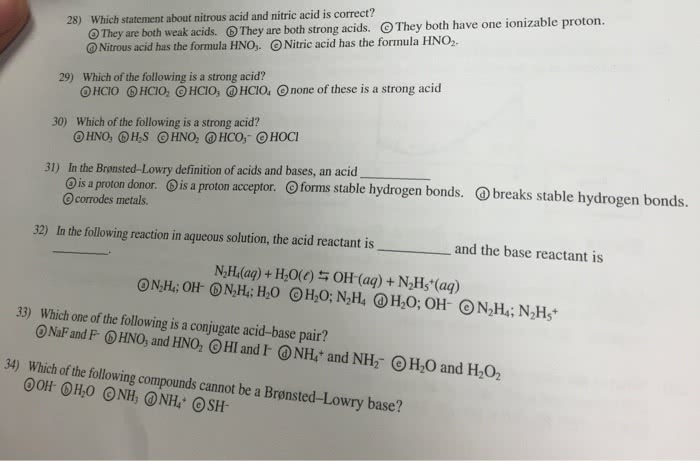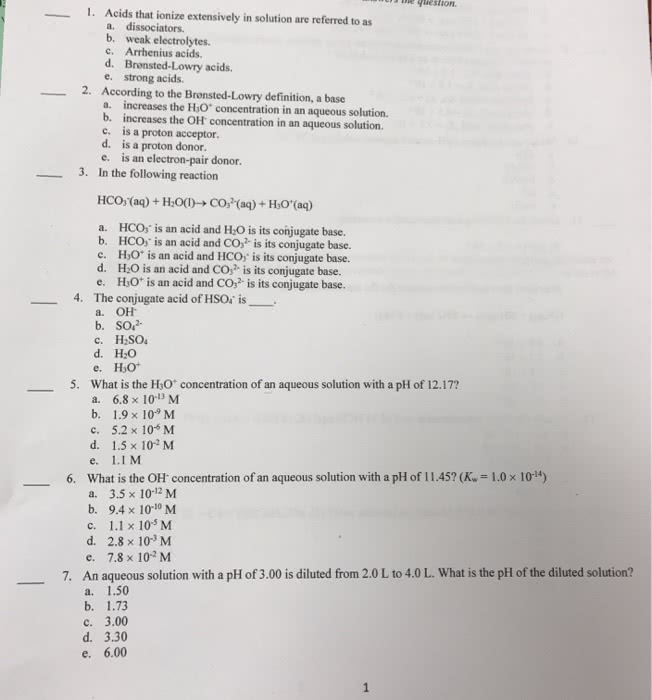CHEM 1312 Lecture Notes - Lecture 7: Chief Operating Officer, Lead, Ph

Chapter 16: Acids and Bases
Focus of this section: Properties of Acids and Bases
Bronsted Acids and Bases:
• originally defined in Chapter 4
-- Acid = proton donor
-- Base = proton acceptor
-- acid/base reaction = proton transfer
HCl (aq) + H2O (l) H3O+ (aq) + Cl– (aq)
acid base
NH3 (aq) + H2O (l) NH4
+ (aq) + OH– (aq)
base acid
• since acid/base reactions are equilibria, there must be acids
and bases on the products side as well!
-- called conjugate acid and base
-- Conjugate base = what remains of the acid after it
donates a proton
-- Conjugate acid = species formed when the base
accepts a proton
HCl (aq) + H2O (l) H3O+ (aq) + Cl– (aq)
acid base conjugate conjugate
acid base
NH3 (aq) + H2O (l) NH4
+ (aq) + OH– (aq)
base acid conjugate conjugate
acid base
• acid and conjugate base = conjugate acid-base pair
base and conjugate acid = conjugate acid-base pair
-- two species in conjugate pair differ only
by one H+

-- there are 2 conjugate pairs in any acid/base rxn
Molecular Structure and Acid Strength:
• The strength of an acid is measured by its tendency to
ionize
= the easier it ionizes, the stronger the acid
• Two factors influence the extent to which the acid undergoes
ionization:
-- strength of the H−X bond
-- Polarity of the H−X bond
Binary Acids = hydrogen and nonmetal
(Hydrohalic Acids = binary acids formed between
hydrogen and the halogens)
Group VIA
Group VIIA
(H2O)
HF
H2S
*HCl
H2Se
*HBr
H2Te
*HI
*strong acids
HX H X
+

-- strength increases as go from left to right in same
period electronegativity of X increases (H–X
more polar)
-- strength increases as go from top to bottom of group
bond strength decreases as go down group
HF << HCl < HBr < HI
H2O < H2S < H2Se < H2Te
Oxoacids = contain hydrogen, oxygen, and a central
nonmetal (X)
-- Contain one or more O–H bonds
-- acidity determined by how groups connected to oxygen
affect the polarity of the O–H bond
= more polar more acidic
• Factors that determine how polarity of O–H is affected:
1. same number of lone oxygens, different X:
-- as electronegativity of X increases, stronger acid
= acidity increases as go up group and from left
to right in period
S
O
O O
O
HH
Se
O
O O
O
HH
Document Summary
Focus of this section: properties of acids and bases. Bronsted acids and bases: originally defined in chapter 4. + (aq) + oh (aq: since acid/base reactions are equilibria, there must be acids and bases on the products side as well! - conjugate base = what remains of the acid after it donates a proton. - conjugate acid = species formed when the base accepts a proton. H3o+ (aq) + cl (aq) conjugate conjugate acid base. + (aq) + oh (aq) conjugate base: acid and conjugate base = conjugate acid-base pair base and conjugate acid = conjugate acid-base pair. - two species in conjugate pair differ only by one h+ - there are 2 conjugate pairs in any acid/base rxn. Molecular structure and acid strength: the strength of an acid is measured by its tendency to ionize. = the easier it ionizes, the stronger the acid: two factors influence the extent to which the acid undergoes ionization:



